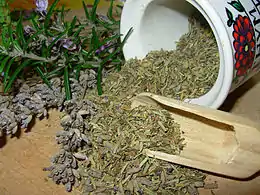Herbes de Provence
Herbes de Provence (French: [ɛʁb də pʁɔvɑ̃s]; Provençal: èrbas de Provença) is a mixture of dried herbs considered typical of the Provence region of southeastern France. Formerly simply a descriptive term, commercial blends started to be sold under this name in the 1970s. These blends often contain savory, marjoram, rosemary, thyme, and oregano. Lavender leaves are also included in products in the North American market. The herb mixture is typically used with grilled foods and stews.

History
...the famous mixtures of herbes de Provence... were unknown to my Provençal grandmothers, who used, individually and with discernment, thyme, rosemary and savory gathered in the countryside.[1]: 138
Provençal cuisine has traditionally used many herbs which were often characterized collectively as herbes de Provence, but not in specific combinations, and not sold as a mixture. It was in the 1970s that homogenised mixtures were formulated by spice wholesalers, including notably Ducros in France (now part of McCormick & Company).[1]: 138
Picking and production
The commercial term "herbes de Provence" is a generic term for a mixture of dried herbs. The expression, which is not an appellation, was created with great success by a French food company in the year 1960.[2][3] This mixture is therefore not protected.[4][5]
These plants have for a long time only been collected in the wild. Today, they are increasingly cultivated by the food industry. Alongside production from the family vegetable garden, or in pots on balconies, this organized production represents half of the market.[6]
Only 10% of dried (or freeze-dried) Provence herbs sold in France are currently produced in France. 95% of so-called "Herbes de Provence" blends currently come from Central and Eastern European countries (Poland and Albania in the lead), the Maghreb, or China.[7]
Herbs used
These mixtures typically contain savory, marjoram, rosemary, thyme, oregano, and other herbs. In the North American market, lavender leaves are also typically included,[8][9] though lavender does not appear in the recipes in Jean-Baptiste Reboul's 1910 compendium of Provençal cooking.[10]
The Label Rouge definition of the mixture contains 19% thyme, 27% rosemary, 27% savory, and 27% oregano.[11]
Sale
As the name herbes de Provence is generic, and does not have Protected Geographical Status, there is no guarantee that any herb mixture on the market actually comes from Provence; indeed, the vast majority of these blends come from central and eastern Europe, North Africa, and China.[12] Herbes de Provence are often sold in larger bags than other herbs, and the price in Provence is considerably lower than for other herbs.
Uses
Herbes de Provence are used to flavour grilled foods such as fish and meat, as well as vegetable stews. The mixture can be added to foods before, during, or after cooking or mixed with cooking oil prior to cooking so as to infuse the flavour into the cooked food. They can also be sprinkled on raw foods such as vinaigrettes, salads or fresh cheese.
See also
- List of herbs
- Fines herbes
References
- Laget, Francis (2005). "From its Birthplace in Egypt to Marseilles, an Ancient Trade: 'Drugs and Spices'". Diogenes. 52 (3): 131–139. doi:10.1177/0392192105055941. S2CID 144212782.
- "Fines herbes et grands secrets - Enquête au cœur des plantes", documentaire de Mélanie Van Der Ende] on YouTube
- "Herbes de Provence". www.inao.gouv.fr (in French). Retrieved May 15, 2022.
- "DUCROS Grillardin : mélange d'herbes de Provence". www.ina.fr (in French). Retrieved May 15, 2022.
- Salagou de Ducros : épices pour la salade on YouTube
- Dictionnaire de la Provence, p. 382.
- Dictionnaire de la Provence, p. 382.
- Crum, Hannah; LaGory, Alex (2016). The Big Book of Kombucha. Storey Publishing. p. 200. ISBN 9781612124339. Retrieved May 15, 2017.
- de Mélogue, François (2015). Cuisine of the Sun: A Ray of Sunshine on Your Plate. Eat Till You Bleed. ISBN 9781682225158. Retrieved May 15, 2017.
- Reboul, Jean-Baptiste (1910). La Cuisinière Provençale.
- "Arrêté du 21 avril 2015 portant homologation du cahier des charges du label rouge LA/02/03 Herbes de Provence".
- Jacques Marseille, ed. (2002). Dictionnaire de la Provence et de la Côte d'Azur. Paris: Éd. Larousse. p. 382. ISBN 2035751055.